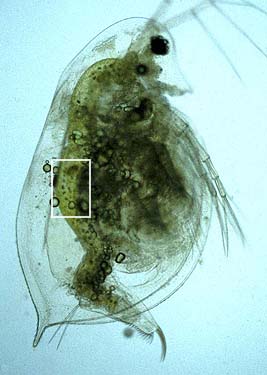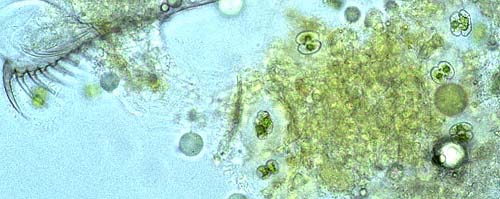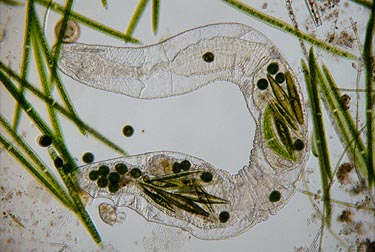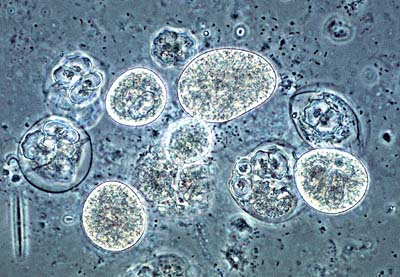Desmid Eaters - desmids in the food webby Peter Coesel, the Netherlands with images from members of the Dutch Desmid Working-group |
Desmids can make a considerable part of the unicellular algal biomass. So they likely are important as a food source for various invertebrates. However, remarkably little scientific literature about this subject can be traced. No doubt this has to do with the fact that most research in this field is focussed on grazing of phytoplankton by zooplankton in deep, often eutrophic water bodies, for desmids the least favourable of all standing freshwater habitats. Yet, desmids have been shown to be a potential food source for zooplankters like cladocera (water fleas) and copepods. For where desmids occasionally cause an algal bloom they have been detected in the guts of cladocera (Infante 1973). From experiments it appeared that planktonic desmid species may be well digested by daphnids, particularly if there is no protecting mucous envelope around the desmid cell, like in Staurastrum chaetoceras. In case of capsulated desmid species, like Cosmarium abbreviatum var. planctonicum, digestion is more problematic (Coesel 1997). |
|
Daphnia galeata fed with a culture of Cosmarium abbreviatum var. planctonicum. In the gut quite a series of intact Cosmarium cells are to be recognized. <<<< mouse-over: Detail of intact Cosmarium cells (protected by a mucilaginous envelope) in the gut of a Daphnia galeata specimen. Image © Peter Coesel |
| Faeces
of Daphnia galeata still containing intact (live?) cells of Cosmarium. Image © Peter Coesel |
|
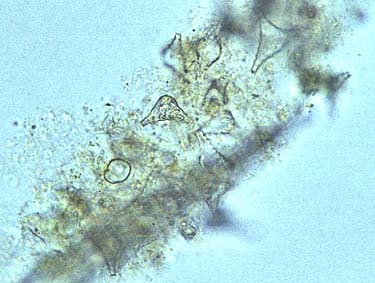 |
Faeces of Daphnia showing empty semicells of Staurastrum chaetoceras. Image © Peter Coesel |
Despite the fact that planktonic desmids are a good potential food source, in practice, because of their low population density, they use to play but a minor role in the pelagial food web (at least in temperate climatic regions, for in the tropics the situation is possibly different). In contrast to that, there are numerous observations of desmids making an important component in the menu of diverse littoral animals, ranging from protozoa to fishes (Brook & Ells 1987; Coesel 1997). In particular where desmids cover the submerged substrate as a green film visible with the naked eye, they are taken up in large numbers by grazers like rotifers, midge larvae, worms etc. |
| A
rotifer with in its gut several Closterium species.
Image © Michael Dingley |
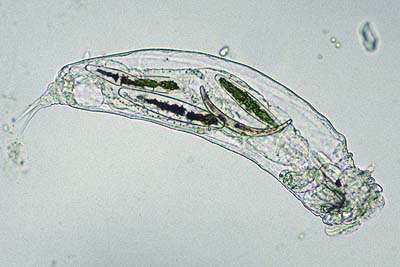 |
|
An oligochaete worm with in its gut various algal species, among which the desmid Closterium moniliferum. Image © Wim van Egmond, <<<< mouse-over |
There are also many uni-cellular organisms that feed on desmids:
|
An Amoeba (Amoeba proteus) using two pseudopods (false feet) to capture Staurastrum brachiatum. Image © Wim van Egmond, mouse-over >>>> |
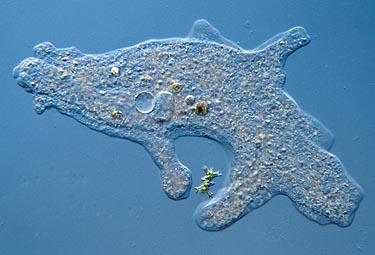 |
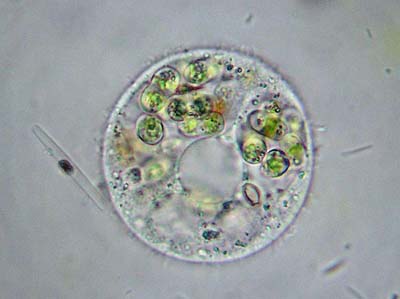 |
A protozoan (helizoan?) enclosing quite a number of small Actinotaenium cells. Image © Koos Meesters |
|
A ciliate enclosing some cells of Micrasterias truncata. Image © Wim van Egmond |
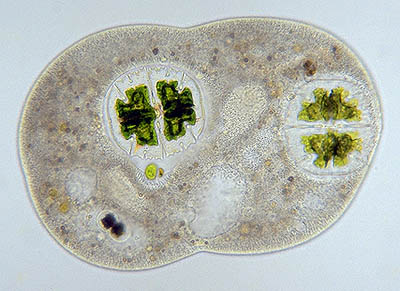 |
Incidentally, cells of desmid species are encountered which are tightly enclosed by a transparent, sharply bordered envelope, about one micrometer in thickness and showing no external sculpture. Phycologists have racked their brains about the possible nature of those envelopes for a long time. According to Wasylik (1962) the most likely originator of that phenomenon would be Chlamydomyxa labyrinthuloides, an amoebe-like organism parasiting on various aquatic plants. Possibly it is identical to the organism described by Lenzenweger (1972) as an amoebe that is specialized in capturing desmids. The relatively sluggish and tough amoebe in question encloses one or more desmid cells and secretes a wall around itself. After having taken in a greater or lesser part of the content of the desmid cells the amoebe slips out, leaving behind an envelope with one or more dead, more or less empty desmid cells. Canter-Lund & Lund (1995: 260-263) picture similar digestion cysts of the amoeboid organism Asterocaelum, predominantly feeeding on centric diatoms. |
| Cells
of an unidentified amoebe together with cells of the desmid Cosmarium
meneghinii.
Image © Henk Schulp, mouse-over >>>> |
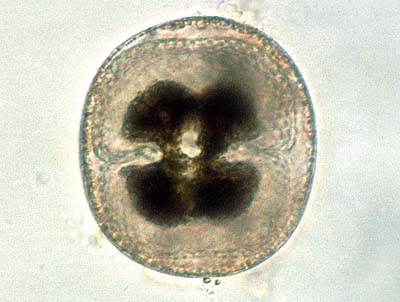 |
A
cell of Cosmarium quadrum encapsulated by a cyst of an unknown
consumer, possibly the amoebe-like Chlamydomyxa labyrinthuloides.
Image © Peter Coesel |
Comments to the author Peter Coesel are welcomed.
